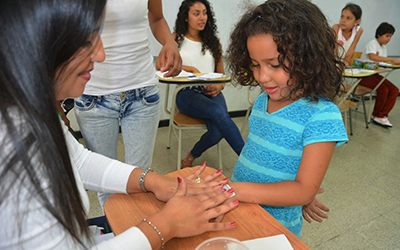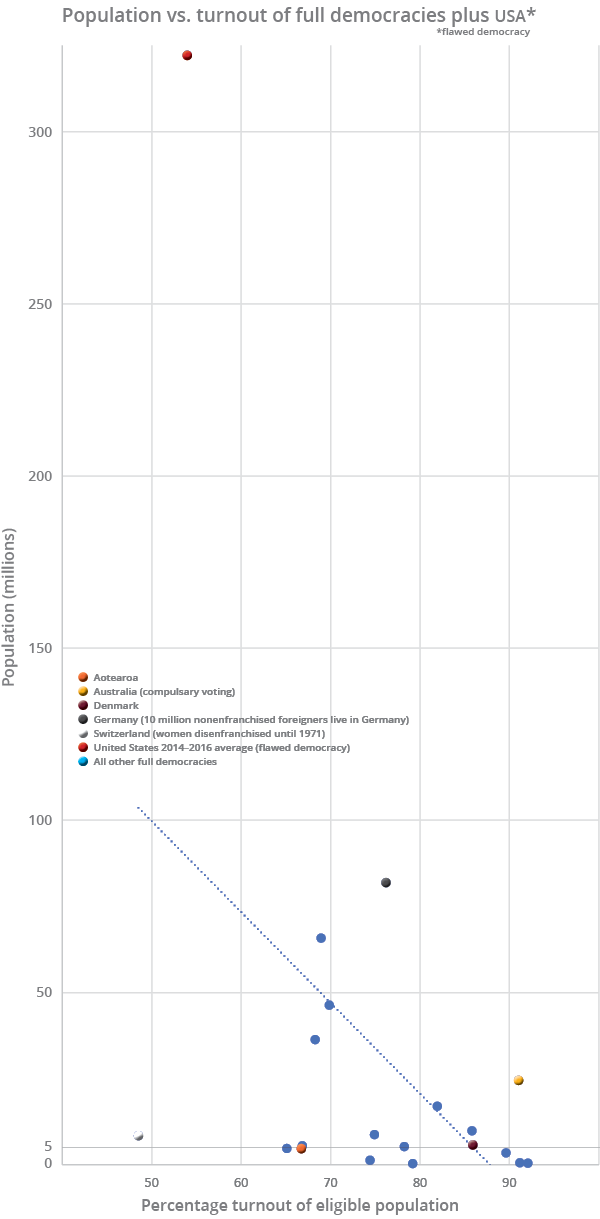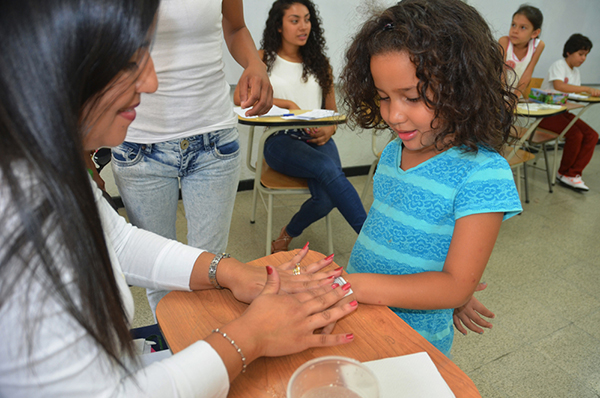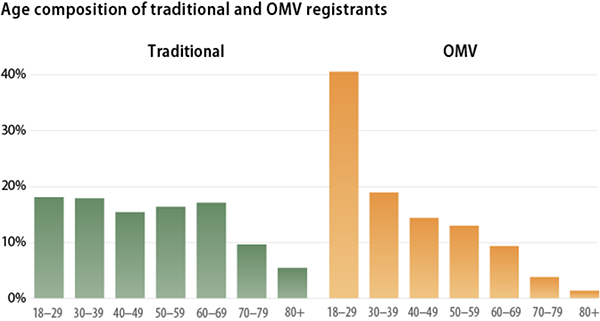Let’s do this, and deliver unperverted democracy


Bigger They Are the Harder They Flaw: To foot it with the best of comparable sized democracies, such as Denmark, New Zealand’s voter turnout needs to be about 20 percentage points better. Malta is the turnout star, but this, paradoxically, reflects a small, permanently polarised community where every vote counts. Also, it’s semi-proportional electoral system suppresses minor parties far more brutally than New Zealand’s 5% threshold. The United States is included, not because it meets the Economist Intelligence Unit’s full-democracy criteria, but to draw attention to fact that the country that considers itself the first modern democracy, doesn’t. Outlier Switzerland’s low voter turnout, in part, reflects the low percentage of women voting—a legacy of the lateness of men to allow women to vote there. chart Mahurangi Magazine x-axis data International IDEA
It would be hard to contrive a more effective means of turning youth off.
After being lectured for months on the importance of enrolling and voting, young people are now told nothing. Not only are they not told how young people voted, they are not even told how many young people enrolled and voted on the same day.
Even the innocuous Kids Voting results are not scheduled to be released until after the official results on 7 October. Given that these votes were cast by 19 September, it is dumbfounding that the perfect opportunity to focus on voting in schools is routinely squandered, but given the vacuum created by an ambiguous general election result, it is particularly lamentable.
It was inevitable that Winston-Peters-as-king-maker and the mixed-member-proportional system itself would receive a caning by the mainstream media, following an election that failed to give either the Labour or National bloc a mandate. Peters would seek to deflect the blame for the delay on coalition negotiations on the Electoral Commission New Zealand, and even Sir Geoffrey Palmer agrees that, post the popularity of advance voting, the delay in counting special votes is intolerable. But it is a bit rich for Peters to complain about any aspect of the electoral system given his almost unrivalled role in bringing the mixed-member proportional into disrepute.
Almost unrivalled, because Jim Bolger and Helen Clark should have called Peters’ bluff following the first mixed-member election in 1996. But so steeped in first-past-the-post thinking were the politicians, and the populace, that the internationally obvious alternative—grand coalition—didn’t get a moment’s consideration. But while the National Party was shameless in its successful—short term—bid to hold onto power, the Labour Party was little better, in claiming victory on the night. Twenty-one years on, the mainstream media should be brimming with articles on the many democracies, notwithstanding Germany’s current dilemma, that have successfully evolved beyond the two-party system. Grand coalition is the only option where the integrity of either major party could be maintained, and it should be rating head and shoulders above a Peters-propped Labour–Green, or National, party government.
As the world’s first full democracy, Aotearoa is performing poorly in respect to voter turnout. Of full democracies in the 4–6 million range, it is better only than Ireland, and is 19 percentage points poorer than Denmark, the darling of the Year in Elections report, if not Europe’s refugees. Denmark was using proportional representation 92 years before Germany adopted the mixed member system 70 years ago—something New Zealand reactionaries would be well to reflect upon before blaming their broadly similar, albeit 141-year-younger proportional representation system for declining voter turnout. And while Aotearoa has been part of the global decline in voter turnout, there has been a recovery of sorts, since the 2011 low point when the bloodless Phil Goff when up against the perfectly-pitched passionless prime minister John Key. It is unsurprising that the uneven contest, which presented no alternative to the globally discredited neoliberalism the former’s Labour Party ambushed the country with in, of all years, 1984, failed to arouse the populace.

New Zealand – Costa Rican Connection: While it has stood Costa Rica in considerable stead, the involvement of children that inspired the Kids Voting programme in the United States failed to prevent significant voter-turnout decline setting in from 1998, when there was little passion for either main party. An opportunity begging to be exploited is for the New Zealand Labour Party, for example, to fully democratise its candidate selection, allow 16-year-olds to vote, but to also allow year-7 and upwards students to parallel vote. Here a Costa Rican child receives a ‘tattoo’ to proclaim she has voted. image Andrés Madrigal | Tico Times
While proximate events can provide an uptick in voter turnout, such as the Dirty Politics election of 2014, and the much smaller Jacinda effect this year, the voter base can only be rebuilt from the bottom up, in the schools. Despite the body of evidence of the efficacy of Kids Voting, Electoral Commission New Zealand devotes only half a page of its 103-page report on the 2014 election to it, and a tepid one-sentence recommendation:
The Commission will be looking to expand Kids Voting and continue to provide and develop curriculum linked resources.
Kids Voting was introduced to Aotearoa from the United States, but was in turn adapted from Costa Rica, which, while it has slumped since, from 1962 to 1994 only once slipped below 80%, and still does about five percentage points better than fellow flawed democracy the United States. Further, and similarly to tree-planting, the participation of children in voting is a two-for, causing parents to vote who would otherwise failed to. Meanwhile, obvious administrative changes elude the commission, such as automatic voter enrolment—just one of the ways Germany, with its more than 17 times larger population, which should work against it, has a 9.48-percentage-point-better voter turnout rate. The commission’s report, in typical New Zealand number-eight fashion, fails to reference how other countries address voter-turnout decline—the only mentions of Germany are the number of votes cast from there977, and, or including (it is unclear), 335 from the New Zealand Embassy. The commission, nevertheless, aspires to be world-leading:
If any country is well placed to achieve [80% turnout of eligible voters] it is New Zealand. We are a small, well-educated nation with a proud democratic tradition. We used to be a world leader in voter participation and we should aspire to be so again.

Oregon Motor-Voter Turbo-Charges Youth: Automatic enrolment with driver license issue or renewal, in Oregon, has had a spectacular impact on youth voter-enrolment there, and probably responsible for the better-than-average, 4.1 percentage point, increase in the 2016 voter turnout, compared with 2012. Although citizens can opt out, Republican politicians opposed the legislation, knowing that that it is not in their self-interest, or that of their party, to have a greater percentage of young people voting—voter suppression and disingenuous angst about voter fraud, their modus operandi. chart Center for American Progress
The report says that, in 2013, it was appreciated:
…that, with no additional funding for participation initiatives, the Commission would need to reallocate resources and prioritise carefully.
It is probable that, in 2017, funding for participation initiatives is still a challenge. This is where lessons from the United States and elsewhere, in respect to concurrent elections, need to be applied here, so that the massive cost-saving across local-body and general elections can be put to work on evidence-based interventions. Add to that the savings from redundant by-elections, and the commission would be in clover.
While the report states that it is in the national interest for there to be multi-party support to reverse the steep downward trend in participation, the antithesis of that is occurring with desperate positioning to form Labour- or National-led coalitions devoid of mandate or integrity. The current, disingenuously advanced proposal is a National–Green government. This would be as lacking in legitimacy as the disastrous 1996 National –New Zealand First government that Jim Bolger remains utterly unapologetic for. That is not to say that the Green Party shouldn’t consider campaigning in the future to go into coalition with either major party, but the only coalition it can enter into with integrity, in 2017, is grand-coalition.
The Greens, Labour, New Zealand First, and National, collectively, have won a robust mandate to, among other things, take meaningful action on climate and eradicate child poverty.
Let’s not waste the next three years. Let’s deliver this!
